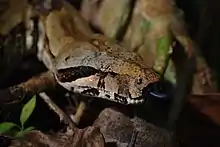| Boa | |
|---|---|
.jpg.webp) | |
| Boa constrictor, B. constrictor | |
| Scientific classification | |
| Domain: | Eukaryota |
| Kingdom: | Animalia |
| Phylum: | Chordata |
| Class: | Reptilia |
| Order: | Squamata |
| Suborder: | Serpentes |
| Family: | Boidae |
| Subfamily: | Boinae |
| Genus: | Boa Linnaeus, 1758 |
| Type species | |
| Boa constrictor Linnaeus, 1758 | |
Boa is a genus of boas found in Mexico, the Caribbean, and Central and South America. Five extant species, and one extinct, are currently recognized.[1]
Etymology
The Online Etymology Dictionary says that the word comes from the "late 14c., "large snake," from Latin boa, type of large serpent mentioned in Pliny's "Natural History;" origin unknown (in medieval folk etymology the name was associated with Greek bous "ox")."[2]
Species
| Image | Scientific name | Common name | Subspecies | Distribution |
|---|---|---|---|---|
.jpg.webp) | Boa constrictor | Boa constrictor or red-tailed boa | 3 | South America (except a small part of the northwest) |
 | Boa imperator | Central American boa, northern boa or Colombian boa | 1 | Mexico, Central America and a small part of northwestern South America |
 | Boa nebulosa | Dominican boa[3] | 0 | Dominica |
 | Boa orophias | St. Lucia boa or San Lucia boa[4] | 0 | Saint Lucia |
 | Boa sigma | Mexican west coast boa | 0 | western Mexico |
| Boa blanchardensis † | Marie-Galante boa | 0 | Marie-Galante (extinct) | |
- ) Not including the nominate subspecies.
Distribution and habitat
Boa species are found in northern Mexico through Central America (Belize, Guatemala, Honduras, El Salvador, Nicaragua, Costa Rica and Panama) to South America north of 35°S (Colombia, Ecuador, Peru, Venezuela, Guyana, Suriname, French Guiana, Brazil, Bolivia, Uruguay and Argentina). One species is present in the Lesser Antilles (Dominica and St. Lucia), on San Andrés, Providencia and many other islands along the Caribbean coasts of Mexico and Central and South America.[5]
Taxonomy
Kluge (1991) moved the genera Sanzinia and Acrantophis into Boa, based on a phylogeny derived from morphological characters.[6] However, it has since been shown that the Malagasy boids and Boa constrictor do not form a monophyletic group, and the lumping of Sanzinia, Acrantophis and Boa was, therefore, an error. These snakes are therefore correctly represented in their own genera: Sanzinia and Acrantophis.[7][8][9]
To add further to the naming confusion, many species of snake in the family Boidae are known colloquially as "boas". Also, four subspecies of B. constrictor are recognized, each with a distinct common name.[7]
References
- ↑ Boa at the Reptarium.cz Reptile Database. Accessed 28 March 2022.
- ↑ "boa | Origin and meaning of boa by Online Etymology Dictionary". www.etymonline.com. Retrieved 2019-09-04.
- ↑ Daltry, J.C.; Powell, R.; Henderson, R.W. (2018). "Boa nebulosa". IUCN Red List of Threatened Species. 2018: e.T74863215A75171341. doi:10.2305/IUCN.UK.2018-2.RLTS.T74863215A75171341.en. Retrieved 18 November 2021.
- ↑ Daltry, J.C. (2018). "Boa orophias". IUCN Red List of Threatened Species. 2018: e.T74866530A75171346. doi:10.2305/IUCN.UK.2018-2.RLTS.T74866530A75171346.en. Retrieved 18 November 2021.
- ↑ McDiarmid RW, Campbell JA, Touré T. 1999. Snake Species of the World: A Taxonomic and Geographic Reference, vol. 1. Herpetologists' League. 511 pp. ISBN 1-893777-00-6 (series). ISBN 1-893777-01-4 (volume).
- ↑ Kluge AG. 1991. Boine Snake Phylogeny and Research Cycles. Misc. Pub. Museum of Zoology, Univ. of Michigan No. 178. 58 pp.
- 1 2 Noonan, Brice; Chippindale, P. (2006). "Dispersal and vicariance: The complex evolutionary history of boid snakes". Molecular Phylogenetics and Evolution. 40 (2): 347–358. doi:10.1016/j.ympev.2006.03.010. PMID 16624591.
- ↑ Vences, Miguel; Glaw, F.; Kosuch, J.; Boehme, W.; Veith, M. (2001). "Phylogeny of South American and Malagasy boine snakes: Molecular evidence for the validity of Sanzinia and Acrantophis and biogeographic implications". Copeia. 2001 (4): 1151–1154. doi:10.1643/0045-8511(2001)001[1151:posaam]2.0.co;2.
- ↑ Reynolds, R.G.; Niemiller, M.L.; Revell, L.J. (2014). "Toward a Tree-of-Life for the boas and pythons: Multilocus species-level phylogeny with unprecedented taxon sampling". Molecular Phylogenetics and Evolution. 71: 201–213. doi:10.1016/j.ympev.2013.11.011. PMID 24315866.
Further reading
- Kluge AG. 1991. Boine Snake Phylogeny and Research Cycles. Misc. Pub. Museum of Zoology, Univ. of Michigan No. 178. 58 pp. PDF at University of Michigan Library. Accessed 11 July 2008.
- Vences M, Glaw F, Kosuch J, Böhme W, Veith M. 2001. Phylogeny of South American and Malagasy Boine Snakes: Molecular Evidence for the Validity of Sanzinia and Acrantophis and Biogeographic Implications. Copeia No 4. p. 1151-1154. PDF at Miguel Vences. Accessed 29 August 2008.
- Vences M, Glaw F. 2003. Phylogeography, systematics and conservation status of boid snakes from Madagascar (Sanzinia and Acrantophis). Salamandra, Reinbach, 39(3/4): p. 181-206. PDF at Miguel Vences. Accessed 29 August 2008.
External links
- Boa at the Reptarium.cz Reptile Database. Accessed 5 July 2008.
- Acrantophis at the Reptarium.cz Reptile Database. Accessed 10 July 2008.
- Sanzinia at the Reptarium.cz Reptile Database. Accessed 10 July 2008.
- iNaturalist page